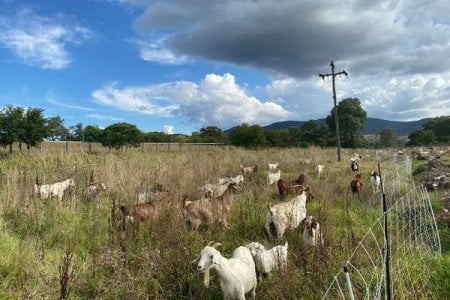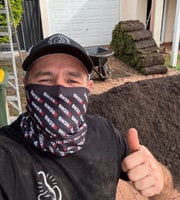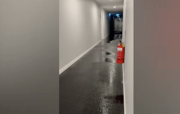You’ve seen bushfires worsen—now even goats are joining the fight
By
Maan
- Replies 0
An unlikely group of heroes has been spotted wandering through a popular tourist destination.
Locals watched in awe as these furry fire-fighters munched their way through thick bushland that machines couldn’t even touch.
And their appetite might just help save lives in the next bushfire season.
The goats of Dry Creek Farm in Mudgee were the stars of an innovative bushfire prevention program carried out at the Putta Bucca Wetlands, a scenic nature reserve located just outside Mudgee in western NSW.
From April to June, the animals were released into areas dense with flammable vegetation—terrain too steep, rocky or wet for traditional machinery.
Under the guidance of the NSW RFS — Cudgegong District, the goats cleared 12.3 hectares of overgrowth, including invasive weed species that choke out native flora.
‘The herd was moved progressively through the site to target over-vegetated areas while avoiding disturbance to environmentally sensitive zones,’ operational officer Hollie Smith shared.
The goats were confined to small sections using temporary fencing and kept there just long enough to reduce high fuel loads without overgrazing the area.
Footage of the herd clambering up hillsides and trotting down walking paths while stripping the land of bushfire fuel won widespread praise online, with some Aussies asking for similar projects in their own communities.
The environmental benefits extended well beyond fire safety.
‘The goats also consume invasive weed species and research shows that after passing through their four-chambered digestive system, only about 15 out of 1,000 seeds remain viable—helping support the natural regeneration of native flora by reducing weed competition,’ Smith explained.
Dry Creek Farm manages a rotating herd of around 200 goats, adjusting their numbers per project to suit the terrain and vegetation.
The Putta Bucca project forms part of an ongoing trial in response to the 2019–20 Black Summer bushfires, initiated by the NSW RFS.
‘Putta Bucca was identified in the Cudgegong District Bush Fire Risk Management Plan and, due to its proximity to residential areas, environmental significance, and limited machinery access caused by thick vegetation growth, it was considered an ideal location for the trial,’ Smith said.
The trial has already been replicated in other regions, including the South Coast, the Liverpool Ranges, and Wellington Caves near Dubbo.
Last year, goats were also deployed in Clandulla following a wet spring that left dense vegetation in its wake.
Another successful project unfolded along the Lue railway corridor within the past four years.
In every location, the community response has been overwhelmingly positive.
‘In both locations, the local communities have enjoyed seeing the goats in action and have taken a strong interest in the valuable role this method plays in bushfire risk management,’ Smith said.
Similar land management strategies have been adopted internationally, with countries such as the US, Canada, Portugal, Spain, Italy and Greece also turning to goats as natural firebreak creators.
Fire season preparations come in many forms—sometimes even involving a hungry herd of goats.
But while land-clearing methods like these offer hope in regional areas, experts warn that more needs to be done in urban settings too.
One fire scientist says the threat is growing fast, and no suburb is truly safe.
Read more: ‘Nowhere to hide’: Fire expert’s chilling warning for Australian suburbs

Could a few hundred hungry goats help protect your town from the next bushfire disaster?
Locals watched in awe as these furry fire-fighters munched their way through thick bushland that machines couldn’t even touch.
And their appetite might just help save lives in the next bushfire season.
The goats of Dry Creek Farm in Mudgee were the stars of an innovative bushfire prevention program carried out at the Putta Bucca Wetlands, a scenic nature reserve located just outside Mudgee in western NSW.
From April to June, the animals were released into areas dense with flammable vegetation—terrain too steep, rocky or wet for traditional machinery.
Under the guidance of the NSW RFS — Cudgegong District, the goats cleared 12.3 hectares of overgrowth, including invasive weed species that choke out native flora.
‘The herd was moved progressively through the site to target over-vegetated areas while avoiding disturbance to environmentally sensitive zones,’ operational officer Hollie Smith shared.
The goats were confined to small sections using temporary fencing and kept there just long enough to reduce high fuel loads without overgrazing the area.
Footage of the herd clambering up hillsides and trotting down walking paths while stripping the land of bushfire fuel won widespread praise online, with some Aussies asking for similar projects in their own communities.
The environmental benefits extended well beyond fire safety.
‘The goats also consume invasive weed species and research shows that after passing through their four-chambered digestive system, only about 15 out of 1,000 seeds remain viable—helping support the natural regeneration of native flora by reducing weed competition,’ Smith explained.
Dry Creek Farm manages a rotating herd of around 200 goats, adjusting their numbers per project to suit the terrain and vegetation.
The Putta Bucca project forms part of an ongoing trial in response to the 2019–20 Black Summer bushfires, initiated by the NSW RFS.
‘Putta Bucca was identified in the Cudgegong District Bush Fire Risk Management Plan and, due to its proximity to residential areas, environmental significance, and limited machinery access caused by thick vegetation growth, it was considered an ideal location for the trial,’ Smith said.
The trial has already been replicated in other regions, including the South Coast, the Liverpool Ranges, and Wellington Caves near Dubbo.
Last year, goats were also deployed in Clandulla following a wet spring that left dense vegetation in its wake.
Another successful project unfolded along the Lue railway corridor within the past four years.
In every location, the community response has been overwhelmingly positive.
‘In both locations, the local communities have enjoyed seeing the goats in action and have taken a strong interest in the valuable role this method plays in bushfire risk management,’ Smith said.
Similar land management strategies have been adopted internationally, with countries such as the US, Canada, Portugal, Spain, Italy and Greece also turning to goats as natural firebreak creators.
Fire season preparations come in many forms—sometimes even involving a hungry herd of goats.
But while land-clearing methods like these offer hope in regional areas, experts warn that more needs to be done in urban settings too.
One fire scientist says the threat is growing fast, and no suburb is truly safe.
Read more: ‘Nowhere to hide’: Fire expert’s chilling warning for Australian suburbs
Key Takeaways
- Goats cleared 12.3 hectares of flammable vegetation at Putta Bucca Wetlands.
- They accessed steep, rocky terrain where machinery could not operate.
- Grazing reduced bushfire risk and helped regenerate native plant life.
- The project forms part of an ongoing NSW RFS trial inspired by the Black Summer bushfires.
Could a few hundred hungry goats help protect your town from the next bushfire disaster?








